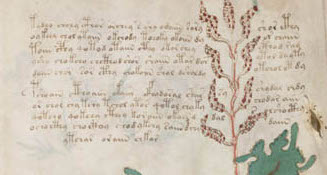

It is currently housed at Yale University, where it is filed as item MS408 in the Beinecke Library of rare books and manuscripts. In that same year, the place of origin of the manuscript, Castello Aragonese on the isle of Ischia, Italy, was bought by a private owner, and it is thought that the document was sold as part of the clearance sale of the grand property. For several centuries it enjoyed an unassuming existence, until 1912 when it was purchased by a Polish book dealer by the name of Wilfred M. The manuscript has been carbon dated to the mid-fifteenth century (1404-1438 AD) and it is thought to have been composed in Northern Italy during the Italian Renaissance. The Voynich Manuscript is a mysterious illustrated hand-written vellum codex, produced in what was thought to have been a written and visual code. This time it appears to have strong academic backing. The report seems very confident, but so have claims before.
#WHAT IS THE VOYNICH MANUSCRIPT PLUS#
It seems there was no ‘code’ to crack as such, just an extinct and previously unknown language to recognize, plus a lot of abbreviations and some complicated diphthongs.
#WHAT IS THE VOYNICH MANUSCRIPT CODE#
If validated (and it has already been peer reviewed) this means he has succeeded where countless cryptographers, linguistics scholars and computer programs have failed - by cracking the code of the 'world's most mysterious text', the Voynich manuscript. One of their associate researchers has published the paper with the solution to the mystery. The press release from University of Bristol in South West England promotes a paper that reveals the secret language of the Voynich manuscript has finally been understood. This attempt, described confidently in a research paper and presented in a press release by a UK university seems to have solid backing. See for yourself! You can look at pages from the Voynich Manuscript here.Claims of ‘cracking the code’ of the Voynich manuscript have lost their sheen somewhat over the last few years, with weak cases being presented from all and sundry. Other medieval Latin scholars will certainly want to weigh in, but the sheer mundanity of Gibbs' discovery makes it sound plausible. Gibbs concluded that it's likely the Voynich Manuscript was a customized book, possibly created for one person, devoted mostly to women's medicine. Once people could just reproduce several copies of the original Trotula or De Balneis Puteolanis on a printing press, there would have been no need for scribes to painstakingly collate its information into a new, handwritten volume. The Voynich Manuscript has been reliably dated to mere decades before the invention of the printing press, so it's likely that its peculiar blend of plagiarism and curation was a dying format. (The women's pseudoscience health website Goop would fit right in during the 15th century.) Even back then, people believed in the pseudoscience of magnets. Gibbs even identified one image-copied, of course, from another manuscript-of women holding donut-shaped magnets in baths. Zodiac maps were included because ancient and medieval doctors believed that certain cures worked better under specific astrological signs. Baths were often prescribed as medicine, and the Romans were particularly fond of the idea that a nice dip could cure all ills. Pictures of plants referred to herbal medicines, and all the images of bathing women marked it out as a gynecological manual. Once he realized that the Voynich Manuscript was a medical textbook, Gibbs explained, it helped him understand the odd images in it. The text would have been very familiar to anyone at the time who was interested in medicine. "The abbreviations correspond to the standard pattern of words used in the Herbarium Apuleius Platonicus – aq = aqua (water), dq = decoque / decoctio (decoction), con = confundo (mix), ris = radacis / radix (root), s aiij = seminis ana iij (3 grains each), etc." So this wasn't a code at all it was just shorthand. "From the herbarium incorporated into the Voynich manuscript, a standard pattern of abbreviations and ligatures emerged from each plant entry," he wrote. His experience with medieval Latin and familiarity with ancient medical guides allowed him to uncover the first clues.Īfter looking at the so-called code for a while, Gibbs realized he was seeing a common form of medieval Latin abbreviations, often used in medical treatises about herbs. Because the manuscript has been entirely digitized by Yale's Beinecke Library, he could see tiny details in each page and pore over them at his leisure. Further Reading So much for that Voynich manuscript “solution” Gibbs writes in the Times Literary Supplement that he was commissioned by a television network to analyze the Voynich Manuscript three years ago.


 0 kommentar(er)
0 kommentar(er)
